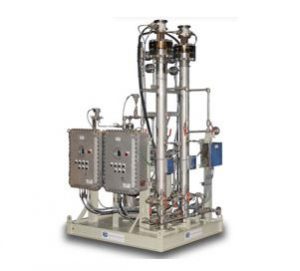Process Heaters, Projects
Electric Process Heater Selection
May 15, 2015 Welcome
The IFS IntegraHeat Electric Heating Package is designed in accordance with IFS-607A technical specification to electrically heat liquids and gases.
Specifying and maintaining Electrical Process Heaters (EPH) requires skills in electrical, chemical and mechanical engineering for each application. Engineering companies divide their engineers into electrical, mechanical and heat transfer groups, seldom soliciting and consolidating comments from these groups into a common specification requirement. The result is an Electric Process Heater (EPH) that is not properly designed.
There are five basic modes of EPH failure to avoid when specifying an EPH.
No flow. If a no-flow situation occurs, the controlling thermocouple senses a need for heat, and the EPH gets hotter and hotter. If the Over-temperature Element (OTE) is working, it will remove power to the EPH.
If the OTE is not working, either the EPH elements or the pressure vessel will melt.
Either way, the process will escape into the atmosphere. Hazardous, explosive and flammable chemicals escaping to the atmosphere through a 1,200°F to 1,600°F opening is dangerous.
Solution: 1) Specify a back-up OTE or 2) test the OTE on a regular basis.
OTE location. If the OTE is on an EPH circuit that has no power and other circuits are on, the OTE will not sense the correct temperature and may lag by several hundred degrees.
Solution: Specify that the OTE and EPH are to be on separate circuits.
OTE wiring. When multiple heaters are wired to a common control panel, it is possible for them to be mistakenly crossed. For example, suppose three heaters are designed to heat a parallel flow of natural gas, and heaters No. 1 and No. 2 are on and heater No. 3 is on standby or off. If the OTE from heater No. 2 is crossed with the OTE from heater No. 3 and flow is suddenly stopped by an upset condition, the OTE on heater No. 3 will not cut power to heater No. 2. Then, either the EPH elements or the pressure vessel will melt.
Solution: Make sure the finished wiring is continuity tested for proper function.
Tube rupture. Much time and effort have been spent investigating tube rupture in shell-and tube exchangers. Ironically, nothing has been published on EPH tube rupture. The primary reason for this is because the inside of an EPH tube Is filled with compressed magnesium oxide (MgO). If a tube did rupture, the MgO would most likely contain the process. However, high pressure processes can easily push the MgO out of the tube and cause a direct leak into the EPH electrical wiring and conduit.
Solution: Make sure to specify the correct EPH tubing (material and pressure rating).
Short. Compressed MgO is an excellent thermal conductor and electrical insulator. Its Achilles heel is that it has a strong affinity for water. For instance, if an EPH is manufactured and shipped, it may stay in a box for a few months. Then, it may go offshore, where someone will open the terminal housing for hook-up. Then, it sits for a few months waiting to be started. If 480v are applied to an EPH with moist MgO, the electrical insulation is lost, and if the circuit breaker doesn ‘t catch the current surge in time, the electrical arc could burn a hole In the EPH.
Solution: Test the integrity of the electrical installation.

